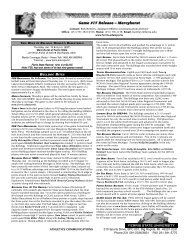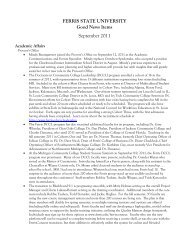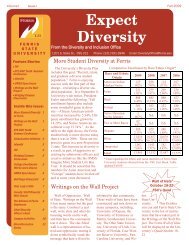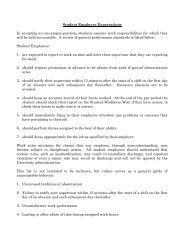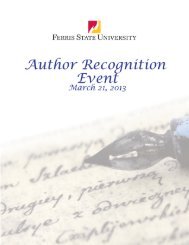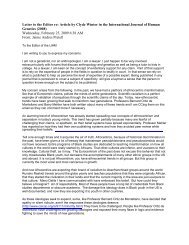Tavia Nyong'o Racial Kitsch and Black Performance - Ferris State ...
Tavia Nyong'o Racial Kitsch and Black Performance - Ferris State ...
Tavia Nyong'o Racial Kitsch and Black Performance - Ferris State ...
You also want an ePaper? Increase the reach of your titles
YUMPU automatically turns print PDFs into web optimized ePapers that Google loves.
plank many stories above the pavement. Finally the gang manages to saw off the<br />
board, <strong>and</strong> Farina plummets to the ground—or rather, his bed, for at this point he<br />
awakens from his dream <strong>and</strong> vows,‘Ah eat mush from now on!’ 30<br />
Incredibly, this is for Maltin simply another example of “the nonmalicious<br />
innocence with which Our Gang always treated the blackwhite<br />
situation.” 31 Race, when it is considered at all, can only be understood<br />
as a “situation” that unhappily intrudes upon the world of<br />
the Little Rascals, one to which they are obliged occasionally to gesture.<br />
Lost in such an analysis is any awareness of the way visual culture<br />
actively produces racial consciousness, in addition to reflecting it.<br />
When, in episode 81, “Election Day” (12 Jan 1929) Farina’s parents,<br />
played by Louise Beavers <strong>and</strong> Clarence Muse, are driven out of town<br />
by a mob of angry whites, Maltin only comments on the “startling illusion”<br />
created by the “visual gag” of the dust cloud they raise. 32<br />
When forced to admit that an episode is a little vulgar (the “Cluck<br />
Cluck Klams” for instance) he simply dismisses those films as inferior<br />
or in poor taste.<br />
In so explaining away the distasteful elements of Our Gang,Maltin<br />
consigns the iconography of racist kitsch to “the great hole of history,”<br />
to use Suzan-Lori Parks’s emotive phrase. 33 It is hard not to imagine<br />
this process as akin to disposing of the evidence of a crime.This manufactured<br />
innocence is hard to bear for those who would still wish to<br />
act against racism in the contemporary world, which explains the<br />
somewhat paradoxical interest, among black <strong>and</strong> anti-racist artists, in<br />
reviving <strong>and</strong> refiguring the iconography of racist kitsch.The other option,<br />
it seems, is to let it all be consigned to the great hole of history.<br />
From Racist <strong>Kitsch</strong> to <strong>Racial</strong> <strong>Kitsch</strong><br />
I find evidence for these claims in the reappearance of racist kitsch at<br />
the very moment where one would have supposed social <strong>and</strong> political<br />
transformations would have made it irrelevant. Spike Lee’s film<br />
Bamboozled (2000) (see Figure 9) indexes <strong>and</strong> extends a long-st<strong>and</strong>ing<br />
practice of African-American curating of the racist kitsch figure. But<br />
in moving this practice from the less-accessible spaces of the private<br />
home or the art gallery to the much broader stage of contemporary<br />
cinema, Lee’s film becomes a crucial site for the close analysis of this<br />
practice of oppositional curating. The film is trapped in the unhappy<br />
dynamic of disseminating an iconography that it cannot stop destroying,<br />
<strong>and</strong> which it therefore cannot stop producing. The alternative to<br />
the evacuated, innocent past proposed by Maltin is one populated<br />
only by racism, a P<strong>and</strong>ora’s box of innumerate little black Sambos<br />
who, like vengeful spirits, arise to destroy all who unwisely invoke<br />
their name.<br />
tavia nyong’o 383






